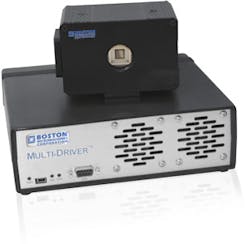Deformable-mirror MEMS improve glaucoma research

The University of Houston College of Optometry (Houston, TX) is using MEMS-based deformable mirrors, Multi-DM, from Boston Micromachines Corporation (BMC; Cambridge, MA) in glaucoma research.
The mirror package, with 140 actuators and low inter-actuator coupling, will be used with wavefront sensorless adaptive optics to image living human eyes. The University of Houston College of Optometry built an Adaptive Optics Scanning Laser Ophthalmoscope (AOSLO) that uses an iterative stochastic parallel gradient descent (SPGD) algorithm to directly control the 140 actuators, maximizing the mean intensity in the acquired retinal images. The DMs are capable of up to 5.5 µm stroke and 100 kHz frame rate, offering sub-nm step size and zero hysteresis.
The research goal is to determine earlier structural markers for glaucoma at the site of initial damage in the optic nerve head, explained Jason Porter, assistant professor at the University of Houston College of Optometry. The high actuator count in BMC's MEMS mirror enables higher-order aberration correction for the researchers. The researchers have used BMC mirrors in previous retinal imaging projects.
Sensorless imaging will provide higher-contrast images of dilated pupils than sensor-based adaptive optics. The lower light requirement of sensorless imaging is beneficial to light-sensitive patients, such as those with rhodopsin disorders in retinitis pigmentosa. Sensorless control also allows direct optimization of the fluorescence signal in autofluorescence imaging.
For more information, please visit www.bostonmicromachines.com.